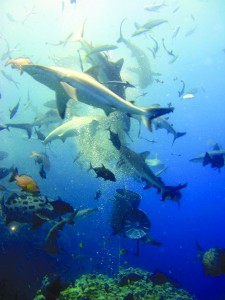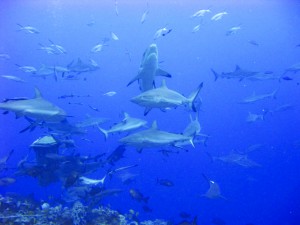By PAUL RUBIO & NICK MOSS
As the sun rises over the Pacific Ocean, we gather on the dive deck and peer down into the clear blue waters. Beneath the boat, large dark shapes swim ominously back and forth in anticipation.
We had travelled from the U.S. for three nights to one of the most pristine and isolated sea mounts of Australia’s Great Barrier Reef. Osprey reef sits 200 miles from Cairns in the Coral Sea and is separated from the mainland by 12 hours of rough seas. Our boat, the Taka Liveaboard, makes this 5 day/4 night trip weekly from Cairns (www.takadive.com.au), although the unpredictable weather in this part of the world can sometimes delay the trip for days, even weeks. In fact, it had been 6 weeks since the crew had been out to Osprey.

Osprey Reef, the most northerly of all the Coral Sea reefs, is known for its exceptional wall diving. The reef covers an area of 50 square miles and its perimeter drops vertically into a half mile of clear Coral Sea water. Exciting dive sites include South Horne, Admiralty Anchor Bommies, Pelagic Gully and Flashlight Ravine, which is most spectacular at night when the flashlight fish are feeding. The most requested site at Osprey Reef is the North Horne, where we had come to today. The North Horne is a reef shelf in depths from 60-125 feet, which drops into deep water. The shelf is covered with numerous hard and soft corals, and deeper still grow large, spiky soft coral ‘trees’ and gorgonians. This shelf attracts many reef fish; however, the North Horne is most famous for its sharks and is a popular shark-feeding location.
Just beneath the boat, and at the base of the dive line, the reef forms a natural amphitheatre, the rock formation allowing divers to sit in a semi circle. Positioned in the middle is a large rock, to which a chain with a float has been attached. From here, bins of frozen tuna heads from our boat can be pulled down to attract the sharks.
As we perch on the walls of the amphitheatre, we peer into the distance, where sharks are beginning to congregate. Usually calm and eerie, the deep water is alive.
Above us, the small dive dinghy powers over and drops the refuse bin, which is then pulled down to the amphitheatre by the dive master. She fiddles clumsily with the lock and opens the lid. The tuna heads spring out and bob in the water, attached to the bin by a chain. The serenity of the moment lasts a second, as the water erupts in a vicious frenzy.
The sharks swim in quickly, ripping the heads apart and swim away gorging on their mouthful. They bite into the heads and writhe back and forth, forcing the meat off the bone. The number of sharks in the water seems to have quadrupled. An initial head count is in vain, as more and more sharks emerge from the deep blue to share in this bounty. The majority of them are large grey reef sharks, a common species in these waters.
We are all no more than 40 feet away from this spectacular event. Any initial fears or trepidation evaporates as we realize that they are not interested in us and instead are concentrated wholly on their next bite. Small black and white tip reef sharks dart into the amphitheatre quickly, pushing aside their bigger competitors and audaciously taking small bites before hurrying away.
As the initial excitement subsides and the heads start to become skeletons, the sharks begin to drift off. But the feeding is not quite over.
Out of the deep blue, a rather large and mysterious silhouette begins to take shape. All of a sudden a large oceanic silver tip is in the amphitheatre. Almost double the size of the grey reef sharks, it feeds with such power and ferocity that the water around it becomes cloudy. The other sharks disperse in fear.
It takes a few minutes over the last of the heads, leaving it in tatters, bobbing pathetically in the water. This signals the end of the feeding and the sharks are soon replaced by smaller, less voracious scavengers. The dive master checks that everyone is alright and has all their limbs intact. Thankfully, we all give a big okay sign, and signal our intention to return to the surface. Everyone in the group starts to climb the dive line, looking back frequently, haunted by the image of the past hour.
Back on deck, the atmosphere is one of intense excitement. We are all aware that we have just been witness to something spectacular and conscious of the incredible controlled aggression of the sharks. The dive team woops and cheers and describes the shark feeding as one of the best that they have been on. We finish the day on the top deck, looking out over Osprey Reef and watch as the waves curl serenely over the top of the reef. As the boat moves away, a humpback whale joins us, breaching the surface as it swims to keep up with the boat.













